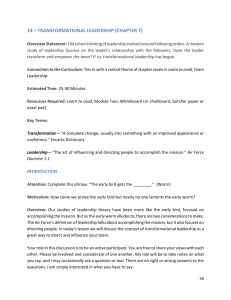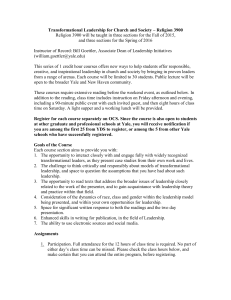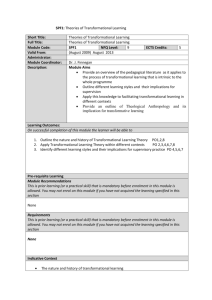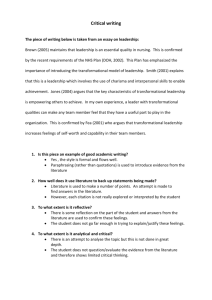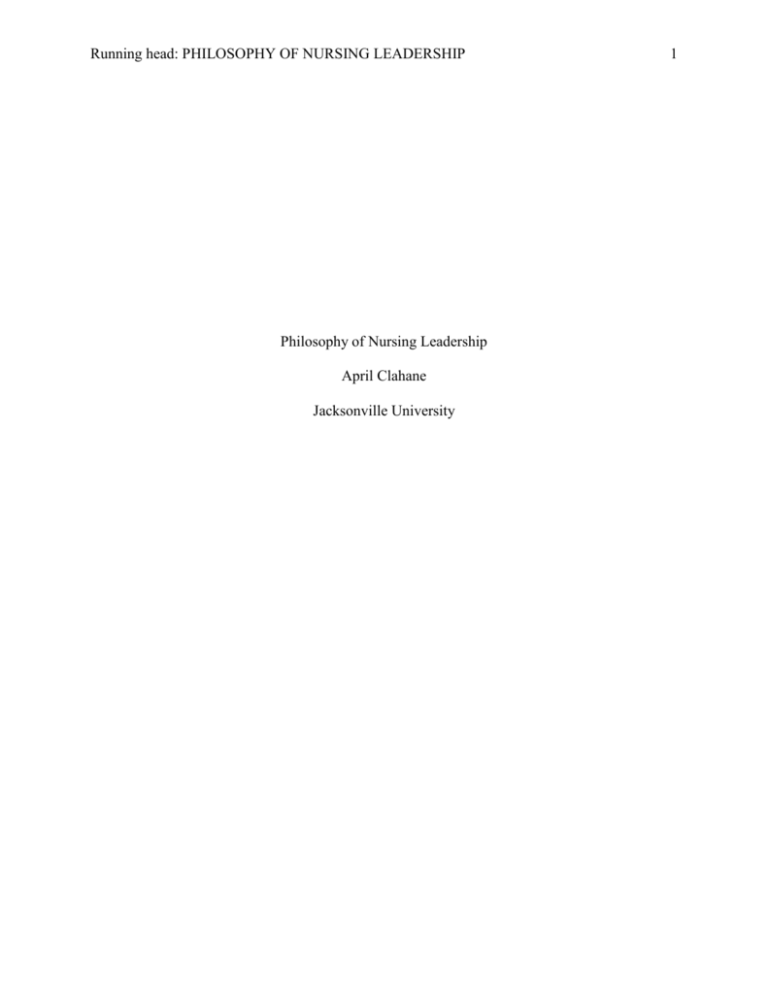
Running head: PHILOSOPHY OF NURSING LEADERSHIP
Philosophy of Nursing Leadership
April Clahane
Jacksonville University
1
PHILOSOPHY OF NURSING LEADERSHIP
2
Philosophy of Nursing Leadership
The state of today’s economic environment is chaotic and what once was viewed as a
temporary situation has quickly faded. The external environmental impact on healthcare
organizations has come fast and furious and the key to an organizations success is its ability to
adapt. Transformational nursing leadership theory is a contemporary theory which aligns itself to
a healthcare organizations ability to adapt to the current external environmental demands.
Transformational Leadership Theory was developed by presidential biographer James
MacGregor Burns in 1978. Burn’s theory provokes leaders to seek a larger vision to
organizational needs, encourages followers to set high expectations, and promote collegial
relationships through a shared governance approach (Bromley & Kirschner-Bromley, 2007). The
transformational leader acts to maximize the needs of the follower, transparently display a
commitment to the organizations mission and vision, and inspire others to align with the
organization by empowerment, team work and facilitating input, through-put and output work
flow (Weberg, 2010). Transformational leadership theory was further developed by Bernard
Bass in the 1970’s who suggested that there are four different components of transformational
leadership; Intellectual Stimulation, Individual Consideration, Inspirational Motivation, and
Idealized Influence. Intellectual Stimulation encourages followers to be creative and allows the
exploration of new innovative ideas. Individual Consideration is the support and open
communication a leader displays so that followers can feel free to express and share ideas and be
recognized for unique contributions. Inspirational Motivation is the transformational leader’s
ability to clearly communicate and inspire followers to have the same passion for achieving the
organizations mission and vision. Idealized Influence is the transformational leader’s natural
PHILOSOPHY OF NURSING LEADERSHIP
3
charisma and connectedness with followers which promotes trust, respect, and co-ownership in
fulfilling goals (Bennett, 2009).
The mission and vision of an organization is the foundation for the structure of its
management leaders. I have worked for a large pediatric hospital for the past 23 years and have
witnessed and been a part of three executive administrations. The current administration brought
in a consultant group to restructure the entire organization. The result of this reorganization over
the past ten years has promoted tremendous growth and a cohesive alignment at all management
levels to the mission and vision of the organization. This was accomplished in part by using a
transformational leadership approach. As a manager in this organization the restructuring I have
been mentored through felt very natural as it aligned with my personal philosophy inherent in the
foundation of a transformational leader. Committed to innovation and growth of staff requires a
transparency in the sharing of information. Shared governance fosters this ability which
intellectually stimulates all levels of staff in an organization thus being able to come together and
create goals, objectives and measureable outcomes. I demonstrate individual consideration by
meeting with each staff member privately every month to discuss what is going well, what needs
to change and if they have the tools they need to do their job. In addition to monthly staff
meetings, I maintain an open door policy. Inspirational motivation develops from open
communication during one-on-one meetings. I am able to explore areas of interest and assign
staff projects which will give meaning to them and which will move the organization to
achieving its mission and vision. Such an example was the need to develop web based training
education. A staff member was very interested in this so a simulation consultant was brought in
and trained a number of staff to create web based training utilizing a software program. To date
we have converted most of our staff education to web based training educational offerings. The
PHILOSOPHY OF NURSING LEADERSHIP
4
staff member in charge delivered a comprehensive report on the outcomes of this method of
teaching demonstrating staff satisfaction and tremendous cost savings for the organization.
Idealized influence is demonstrated in my personal passion for making a positive contribution to
the organization and leading others with that same passion. Team building activities are used to
reinforce and strengthen relationships and maintain a cohesive group (Sullivan & Decker, 2009).
A number of educational, motivational, and accountability programs have been initiated
by the organization I work in which are directly linked to transformational leadership theory.
Such initiatives are achievement of Magnet status, establishing a Journey to Excellence, and
organizational respect principles such as: Integrity, Customer-First, Accountability, Respect,
Excellence (ICARE) and Acknowledge, Introduce, Duration, Explanation, Thank (AIDET). The
principles of a transformational leader are a natural fit for my view of a leader and how I
perceive myself as a leader. My leadership values have not changed since beginning school to
receive my bachelors however I believe I have become more aware of the global effects a true
transformational leader can have on an organization.
PHILOSOPHY OF NURSING LEADERSHIP
5
References
Bennett, T. M. (2009). A study of the management leadership style preferred by IT subordinates.
Journal of Organizational Culture, Communications and Conflict, 13(2), 1-25.
Bromley, H. R., & Kirschner-Bromley, V. A. (2007, November). Are you a transformational
leader?. The Physician Executive, 33(6), 54-57.
Sullivan, E. J., & Decker, P. J. (2009). Effective leadership and management in nursing (7th ed.).
Upper Saddle River, NJ: Pearson Prentice Hall.
Weberg, D. (2010, July). Transformational leadership and staff retention An evidence review
with implications for healthcare systems. Nursing Administration Quarterly, 34(3), 246258.(Sullivan & Decker, 2009)

